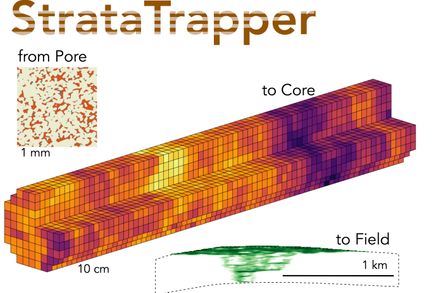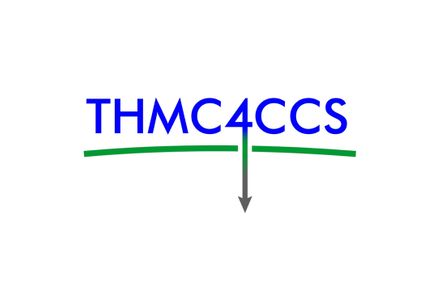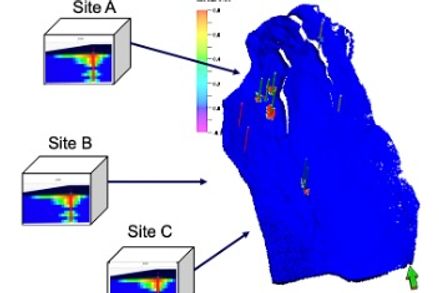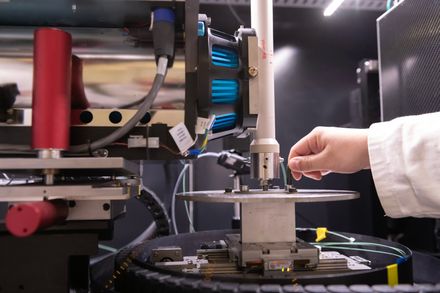We investigate the physics, chemistry, and techno-economics of CO2 storage underground
Our research includes exploring fundamental pore scale fluid dynamics, developing digital rocks analysis techniques, increasing the accuracy of field scale reservoir simulation, and evaluating the feasibility of scaling up CO2 storage to climate relevant scales.
Our Research Projects

StrataTrapper Advanced Modelling of CO2 Migration and Trapping

THMC4CCS: ThorougH experiMental and numerical investigation of Coupled processes for geologiC Carbon Storage
Results
- Showing results for:
- Reset all filters
Search results
-
Book chapterKrevor S, Blunt MJ, Trusler AJPM, et al., 2020,
An Introduction to Subsurface CO<sub>2</sub> Storage
, CARBON CAPTURE AND STORAGE, Editors: Bui, Dowell, Publisher: ROYAL SOC CHEMISTRY, Pages: 238-295, ISBN: 978-1-78801-145-7- Author Web Link
- Cite
- Citations: 3
-
Journal articleGarfi G, Lin Q, Berg S, et al., 2019,
Fluid surface coverage showing the controls of rock mineralogy on the wetting state
-
Journal articleGarfi G, John CM, Berg S, et al., 2019,
The sensitivity of estimates of multiphase fluid and solid properties of porous rocks to image processing
, Transport in Porous Media, Vol: 131, Pages: 985-1005, ISSN: 0169-3913X-ray microcomputed tomography (X-ray μ-CT) is a rapidly advancing technology that has been successfully employed to study flow phenomena in porous media. It offers an alternative approach to core scale experiments for the estimation of traditional petrophysical properties such as porosity and single-phase flow permeability. It can also be used to investigate properties that control multiphase flow such as rock wettability or mineral topology. In most applications, analyses are performed on segmented images obtained employing a specific processing pipeline on the greyscale images. The workflow leading to a segmented image is not straightforward or unique and, for most of the properties of interest, a ground truth is not available. For this reason, it is crucial to understand how image processing choices control properties estimation. In this work, we assess the sensitivity of porosity, permeability, specific surface area, in situ contact angle measurements, fluid–fluid interfacial curvature measurements and mineral composition to processing choices. We compare the results obtained upon the employment of two processing pipelines: non-local means filtering followed by watershed segmentation; segmentation by a manually trained random forest classifier. Single-phase flow permeability, in situ contact angle measurements and mineral-to-pore total surface area are the most sensitive properties, as a result of the sensitivity to processing of the phase boundary identification task. Porosity, interfacial fluid–fluid curvature and specific mineral descriptors are robust to processing. The sensitivity of the property estimates increases with the complexity of its definition and its relationship to boundary shape.
-
Journal articleZahasky C, Jackson S, Lin Q, et al., 2019,
Pore network model predictions of Darcy-scale multiphase flow heterogeneity validated by experiments
-
Journal articleSpurin C, Bultreys T, Bijeljic B, et al., 2019,
Mechanisms controlling fluid breakup and reconnection during two-phase flow in porous media
, Physical Review E, Vol: 100, ISSN: 2470-0045The use of Darcy's law to describe steady-state multiphase flow in porous media has been justified by the assumption that the fluids flow in continuously connected pathways. However, a range of complex interface dynamics have been observed during macroscopically steady-state flow, including intermittent pathway flow where flow pathways periodically disconnect and reconnect. The physical mechanisms controlling this behavior have remained unclear, leading to uncertainty concerning the occurrence of the different flow regimes. We observe that the fraction of intermittent flow pathways is dependent on the capillary number and viscosity ratio. We propose a phase diagram within this parameter space to quantify the degree of intermittent flow.
-
Journal articleSpurin C, Krevor S, Bultreys T, et al., 2019,
Intermittent fluid connectivity during two-phase flow in a heterogeneous carbonate rock
-
Journal articleSpurin C, Bultreys T, Bijeljic B, et al., 2019,
Intermittent fluid connectivity during two-phase flow in a heterogeneous carbonate rock
, Physical Review E, Vol: 100, ISSN: 2470-0045Subsurface fluid flow is ubiquitous in nature, and understanding the interaction of multiple fluids as they flow within a porous medium is central to many geological, environmental, and industrial processes. It is assumed that the flow pathways of each phase are invariant when modeling subsurface flow using Darcy's law extended to multiphase flow, a condition that is assumed to be valid during steady-state flow. However, it has been observed that intermittent flow pathways exist at steady state even at the low capillary numbers typically encountered in the subsurface. Little is known about the pore structure controls or the impact of intermittency on continuum scale flow properties. Here we investigate the impact of intermittent pathways on the connectivity of the fluids for a carbonate rock. Using laboratory-based micro computed tomography imaging we observe that intermittent pathway flow occurs in intermediate-sized pores due to the competition between both flowing fluids. This competition moves to smaller pores when the flow rate of the nonwetting phase increases. Intermittency occurs in poorly connected pores or in regions where the nonwetting phase itself is poorly connected. Intermittent pathways lead to the interrupted transport of the fluids; this means they are important in determining continuum scale flow properties, such as relative permeability. The impact of intermittency on flow properties is significant because it occurs at key locations, whereby the nonwetting phase is otherwise disconnected.
-
Journal articleSpurin C, Krevor S, Bultreys T, et al., 2019,
Mechanisms controlling fluid break-up and reconnection during two-phase flow in porous media
-
Journal articleJackson S, Lin Q, Krevor S, 2019,
Representative elementary volumes, hysteresis and heterogeneity in multiphase flow from the pore to continuum scale
-
Journal articleDe Simone S, Jackson SJ, Krevor S, 2019,
The error in using superposition to estimate pressure during multi‐site subsurface CO 2 storage
, Geophysical Research Letters, Vol: 46, Pages: 6525-6533, ISSN: 0094-8276Analytic pressure estimates for multisite CO2 injection are typically performed through the superposition of single‐site injection models. This is theoretically invalid for multiphase flow because of its nonlinearity. We quantify the error associated with the application of superposition in scenarios with sites located in a rectangular grid geometry. We show that the use of superposition results in overestimates of the pressure buildup, because it neglects the presence of multiple CO2 plumes, which increase the reservoir fluid mobility. The adoption of a dimensionless time scaled to the geometric average between the advective and diffusive characteristic times allows us to define a general model for the maximum error, which may be used to evaluate the validity of using superposition, or to correct the pressure estimates when errors are significant. This procedure can be applied to any analytical solution and advances the extension of single‐well models to scenarios of multiple injection sites.
This data is extracted from the Web of Science and reproduced under a licence from Thomson Reuters. You may not copy or re-distribute this data in whole or in part without the written consent of the Science business of Thomson Reuters.



